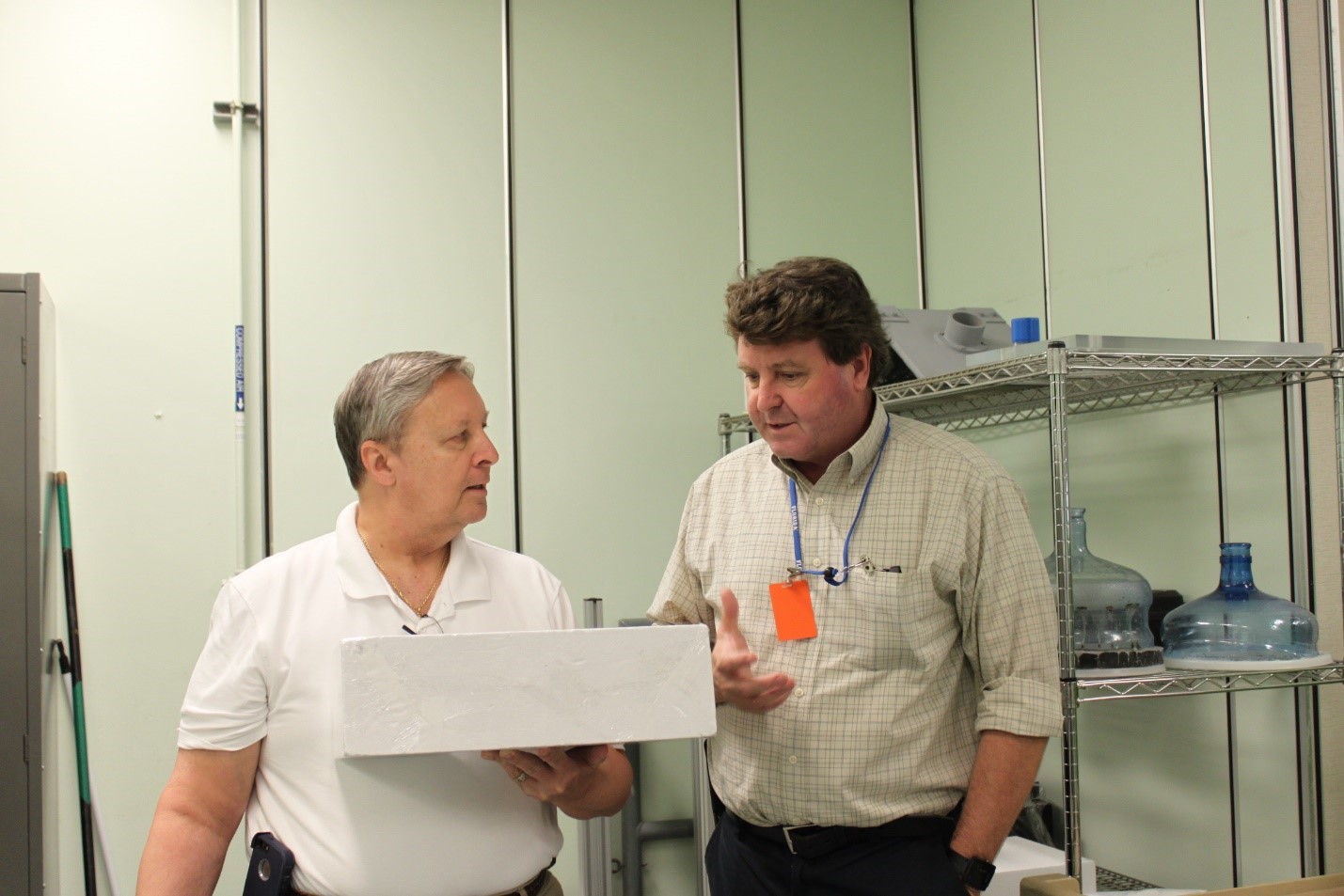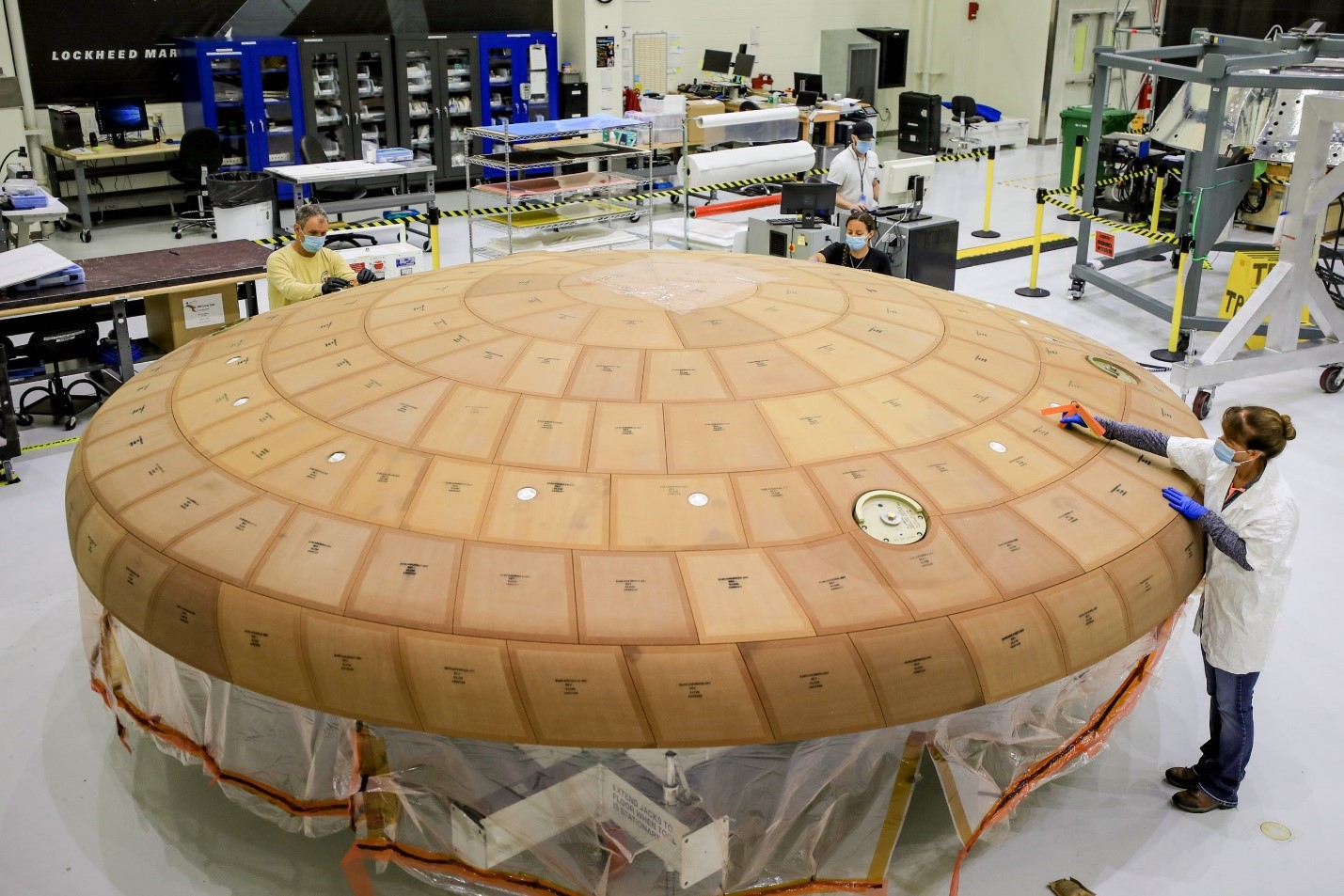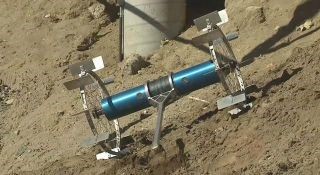-
NASA Orion and Artemis heat shields
10/25/2020 at 20:39 • 0 comments![]()
The 16.5 foot diameter Artemis heat shield (Image from NASA/Glenn Benson)
I had visited NASA’s Kennedy Space Center (KSC) in Florida where I had the pleasure of touring the Thermal Protection System Facility (TPSF) Annex run by Jacobs Space Operation Group. Martin Wilson gave me a guided tour. Wilson has a wealth of experience working with a variety of materials that were used on NASA’s Space Shuttle fleet which last flew in 2011.
Wilson, working in this field since the early 90s, has also developed thermal protection for the Orion spacecraft as well as the Artemis program. Advanced heat resistant materials are needed to protect the space vehicles upon re-entry back into the Earth’s atmosphere.
A lightweight surprise
The Space shuttle heat protection tiles weighed approximately 9 pounds per cubic foot. In his lab, Wilson picked up an Orion heat shield tile and said “catch” while he tossed it to me. I braced myself to catch a heavy tile, but when I caught it, the tile was as light as a piece of Styrofoam! Wilson was able to creatively manufacture these new tiles which would add far less weight than previous designs.
![]()
Figure 1 Thermal protection expert Martin Wilson is shown here on the right and Steve Taranovich is on the left of this photo holding a surprisingly lightweight Thermal demo tile that will be shaped to fit on the sides and top of the conical Orion spacecraft. (Image from Loretta Taranovich)
The Space Shuttle heat shielding
During re-entry, the Space Shuttle endured temperatures as high as 3,000 degrees F (1,650 degrees C) into Earth’s atmosphere.
The Space Shuttle tiles varied in thickness from 1 inch (2.54 centimeters [cm]) to 5 inches (12.7 cm) depending on the heating to which they would be subjected. The silica tile material is referred to as LI-900. It insulates heat so well that tiles can be held bare-handed on one side even while the opposite side is still red hot. LI-900 has a density of 9 pounds per cubic foot (144.2 kilograms per cubic meter [kg/m³]). They are made from pure silica glass fibers, but 94 percent of the volume of each tile is pure air, making each tile fairly light and strong!
Approximately 24,300 tiles were installed on each Space Shuttle, and each tile was designed to survive 100 trips to space and back.
Orion’s heat shield takes the brunt of the heat upon re-entry
In a new process, several large blocks of an ablative material called Avcoat, which is licensed from Boston-based Textron Systems, were produced at the Michoud Assembly Facility in New Orleans by Lockheed Martin. These blocks were shipped to Kennedy Space Center, where Lockheed Martin technicians machined them into more than 186 unique blocks and bonded them to the heat shield's surface.
The ablative material known as “Avcoat” were machined into 186 unique smaller blocks, and then applied by technicians onto the 16.5-foot-diameter (5-meter) heat shield’s underlying titanium skeleton and carbon-fiber skin.
![]()
Figure 2 Orion's new heat shield, for the Artemis-2 mission, is the largest of its kind developed for missions that will carry astronauts. The heat shield base structure has a titanium truss covered with a composite substrate skin composed of layers of carbon fiber material. (Image from NASA)
To fill tiny gaps between these blocks, the seams needed to be filled with a mixture, which over time, would become solid. Technicians then applied a coat of white epoxy paint to the heat shield's surface and also applied aluminized tape after the painted surface dried. The tape provides surface resistivity and will absorb solar heat and infrared emissions.
NASA chose an ablative heat shield which will slowly burn off since it is able to handle higher temperatures than the Space Shuttle tiles which were re-usable.
Unlike the Space Shuttle and other low-Earth-orbiting vehicles, which begin their entry into the atmosphere at close...
Read more » -
NASA “Tipping Point” technology
10/18/2020 at 21:39 • 0 comments![]()
Early in 2020, NASA’s Space Technology Mission Directorate (STMD) prioritized funding opportunities for public-private partnerships to achieve goals that would expand capabilities and opportunities in space. This effort will increase collaboration with the commercial space sector to leverage emerging markets and meet NASA's strategic goals. NASA's investment in industry partnerships will reduce development costs and accelerate the deployment of emerging space system capabilities.
Just recently, NASA selected 14 companies to develop varied technologies to foster a sustainable Artemis program on the Moon by 2030. One of these companies is called Astrobotic Technology which was given $5.8M. The company will demonstrate a fast, wireless charging system that will address the challenges associated with using that technology on the Moon. The effort will build and deliver flight units for potential use on commercial robotic landers. Astrobotic will collaborate with NASA Glenn and has teamed with WiBotic of Seattle to begin developing this technology.
Wireless charging in space and on the Moon involves wireless transmission for power systems whose mechanical connections, if used, would be prone to getting clogged with lunar dust. Wireless systems never mechanically wear out! Figure 1.
![]()
Figure 1 WiBotic wireless charging systems consist of four primary hardware components: Transmitter Unit, Transmitter Antenna Coil, Onboard Charger Unit, Receive Antenna Coil (Image from WiBotic)
For the system to deliver wireless power, the Transmitter will first check to be sure a robot is within range. The system is so flexible that even robots with completely different battery voltages can share the same Transmitter Unit. It automatically recognizes each robot and adjusts charge parameters accordingly.
The components allow for extremely effective charging station deployment. The stations deliver power opportunistically to keep robots topped off and operating for long periods. This is much better than the outdated “full drain and recharge strategy” seen elsewhere.
WiBotic will deliver the power behind autonomous vehicle operations on the Moon. These rovers can get a fast wireless charge when near any number of wireless charging stations situated around the Moon’s surface. Rovers do not have to mechanically connect to these stations, the wireless proximity charging allows rovers to get a quick charge for maximum rover uptime or a longer charge when needed so that they will be able to perform their tasks almost continuously around the clock (i.e. the Lunar clock)
Applications for wireless power on the Moon
Applications that will need proximity chargers on the Moon include the marsupial roving missions, for robotic systems that have no onboard nuclear or solar power generators, charging toolkits on crewed lunar terrain vehicles, and powering the heaters of critical devices to survive the cold, cold lunar night. Temperatures on the Moon are very hot in the daytime, about +100 degrees C. At night, the lunar surface gets very cold, as cold as -173 degrees C. Figure 2.
![]()
Figure 2 NASA's Axelrover is a whirling robot designed for the very challenging terrain on the Moon and beyond. NASA refers to a robot like the Axel rover as a 'tethered marsupial rover' because it would spend most of its time attached to a larger vehicle (Like a baby kangaroo in its mother’s pouch) until it is needed. (Image from NASA/JPL)
Here is a video of an older Astrobotic rover for the Moon at NASA’s Glenn research center. It is an old 2013 video but it gives a great example of what these rovers can do.
Astrobotic is basically developing custom designs, sensor systems, and rovers for planetary surface missions on the Moon, later on Mars and maybe even an asteroid or two. These rovers will autonomously explore, engage in site preparations, as well as resource extraction. The rovers will have co-location technology...
Read more » -
NASA water recycling on the ISS can help people on Earth too
10/14/2020 at 00:36 • 0 comments![]()
A difficult problem NASA has faced since the early days of space travel is the need to efficiently filter water. There is a huge cost to carry water into space: When blasting off from a Kennedy Space Center launch pad, the rocket must overcome and escape Earth’s gravity pull. Every pound counts and contributes to more rocket fuel needed to break free of Earth’s gravity pull. Water costs $10,000 per pound and one gallon of water weighs 8.33 pounds! Since astronauts are limited to three gallons a day that costs $249,000 each day---per astronaut. To mitigate this problem, all types of moisture must be recycled into drinking water aboard any spacecraft.
I met an astronaut at NASA Ames Research Center in California during a visit to a laboratory there working on a unique water filtration system. The astronaut met me with a beacon of urine in one hand and a cup of coffee in the other. His comment, with a big smile was, “On the International Space Station (ISS), tonight’s urine is tomorrow morning’s coffee!”
On the ISS, every drop of moisture, from humidity to urine, is filtered, purified, and reused. However, the current system depends heavy upon specialized filtration beds that weigh down resupply missions and need to be swapped out every 90 days. This system unfortunately fails to filter out certain semi-volatile contaminants.
The Advanced Water Recycling group at NASA’s Ames Research Center, developed a possible unique solution which does the job and can ultimately lead to a smaller, low-cost, light weight solution for the ISS and other future endeavors to the Moon and Mars and beyond. Figure 1.
![]()
Figure 1 The water recovery component of the Environmental Control and Life Support System or ECLSS (Image from NASA)
There are two key components which make up the ISS Regenerative ECLSS: The Water Recovery System, or WRS, and the Oxygen Generation System, or OGS. The WRS conducts the water purification and filtration process in the ECLSS. From this WRS, commercial companies accessed this technology from NASA and began to adapt it to a simpler Earth-based water treatment system for areas around the world with no access to drinkable water.
NASA's previous research provided the Microbial Check Valve, or MCV, an integral component of the purification and filtration process. This is an iodinated-resin which provides a basic means of controlling microbial growth in water without using any power. By dispensing iodine into the water, an important secondary nutritional function for the populace is an added benefit. This chemical, when added to the diet, is known to promote proper brain functions and maintain bodily hormone levels to regulate cell development and growth. Children who lack iodine in their diets can exhibit growth mental retardation.
There are many, many other people around the world who are forced to use water contaminated by livestock that they sift through a cloth fabric to remove dirt and debris. Clean water, for many people, is too far away from villages which makes transporting that water to their village virtually impossible. See Figure 2.
![]()
Figure 2 Shown here are volunteers installing and testing a water purification system in Kendala, Iraq. The Microbial Check Valve is in action here (Image from Concern for Kids)
Mimicking human kidneys
Peter Holme Jensen, CEO and cofounder of the company Aquaporin A/S, commented “Nature is our biggest R&D lab. Whatever discoveries nature has made, they’re quite efficient.” Jensen met Michael Flynn, the lead for the Advanced Water Recycling group at NASA’s Ames Research Center. Flynn introduced a possible solution on which he and his NASA colleagues had been working.
The project was to develop a water filtration system based on aquaporins—the proteins that all living cells use to transfer water through their membranes. Aquaporins enable plant roots to absorb water from soil and also for human kidneys, to filter about 45 gallons of...
Read more »
My Pages
Things I've Built
Model 495 Radiation Hazard Meter (RAHAM)
An instrument to measure microwave power levels. NASA used one on the Space Shuttle
Model 490 Pulse Power Meter
A test instrument to measure and display microwave pulsed power signals up to 20 GHz
Audio speaker design
Designed woofer, mid-range, and tweeter speakers for both floor standing and bookshelf designs
Projects I Like & Follow
Share this profile
ShareBits
Become a Hackaday.io Member
Create an account to leave a comment. Already have an account? Log In.









 John
John Curt White
Curt White Drew Pilcher
Drew Pilcher David Scholten
David Scholten Casual Cyborg
Casual Cyborg Ahmed Azouz
Ahmed Azouz ActualDragon
ActualDragon andriy.malyshenko
andriy.malyshenko Federico Pietro Briata, IZ1GLG
Federico Pietro Briata, IZ1GLG gbm
gbm Clay Graham
Clay Graham Pedro Minatel
Pedro Minatel shashikanth
shashikanth Electroniclovers123
Electroniclovers123 carbono.silício
carbono.silício